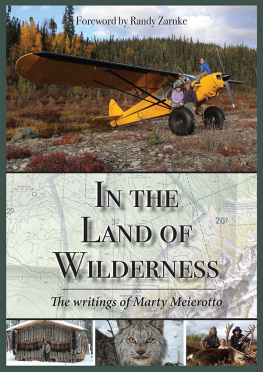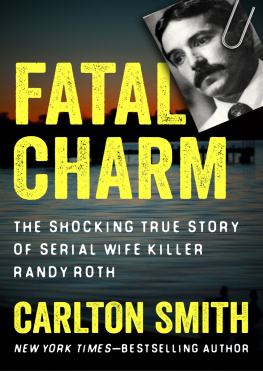THE TRAPPER
By
Lloyd Antypowich
Copyright Statement
No part of this book may be reproduced ortransmitted in any form or by any means, electronic or mechanical,including recording, photocopying, or by any information storageand retrieval system, without the written permission of thepublisher.
Smashwords Edition
Table of Contents
A HUNTING We Did Go
Lloyd is an avid hunter, he loves themountains, and has a great knowledge of the animals in thewilderness. This book makes the reader fell like they are ridingalong on the journey with him, experiencing the beauty of nature,the thrill of the hunt, as well as the animal he was stalking. Timeand again, people have said, I felt like I was right there withyou.
Moccasins to Cowboy Boots
This is a journey of the authors life as hefollowed his dream to become a rancher. Filled with history andhumor, his journey takes him from the homestead where he was bornin the northern wilderness of Saskatchewan. Then moved to northernAlberta where his family logged and sawmilled. Later, he worked inthe oil fields and road construction, then he became a farmer atStettler, Alberta, and a coal miner at Elkford, British Columbia.But his dream carried him into the south Cariboo, where he bought aranch at Horsefly, British Columbia, and become a logger to helpsupport his dream. This is not a diary of his life, but a humorousand determined journey of a man who refused to ever accept no orcant for an answer, until he achieved his goal.
Horns and Hair of the High Country
This is a collection of stories based on theauthors experience of these animals in the wild. An elk, grizzly,goat, sheep, and a Cariboo. Closing with a section that he shareswith you some real-life experiences. These are all wildernessanimals, and the book portrays how they might feel as theyassociate with and are confronted by humans. This book draws uponthe authors intimate experience with animals of the wild. Thisbook will be enjoyed by those who know animals, those who arecurious and young and want to learn more about the animals of thewild.
Chip OFF the OLD block
This is a tribute to the authors daughter,Cherie Jackson Maitland. They have a very deep bond and are verymuch alike. Except she is a female who comes in a very tinypackage, and he is a big strong man. He is constantly amazed bywhat she accomplishes and is delighted that she shares his love forthe mountains, and loves to be out in them with her husband who isa guide and outfitter. A wonderful read about a courageous littlepackage of dynamite, a true chip off the old block.
Louisiana Man
This is a fictional book inspired by a manthe man the author spent an afternoon with while he was in his lateteens. This man had lived a remarkable life and was happy to sharehis harrowing life stories, as well as showing off the spots in hisback where buckshot still lay under the skin. The hero of thisstory, Tom Menzer, is the authors reincarnation of this sort ofman. Tom Menzer leaves his home in Louisiana to follow his dream.This is a story in the best of historical Western tradition, filledwith drama, insight into the Indian culture in the late 1800s, therole of the white man as they pushed them aside, the struggles of aman who had a foot in both camps, and his journey into Canada toavoid the conflict. It is a tale well worth your read.
I dedicate this book to all the Trappers oldand young, but to the old ones who have tramped many miles on snowshoes and used dog teams for transportation, I take my hat off toyou. You will understand this book as it was meant to be. To allthe bush pilots that have flown that northern land, before all themodern equipment came available, when the compass was your maininstrument. Before all the roads, seismic lines and oil developmenttook place. And to any of you who just might have walked away froma hard landing. To all the pioneers who were brave enough to havepioneered that north country. And to the natives, that lived wherefew other people dared to live; you are a courageous people.
In the mid fortys/early fiftys, the town ofSlave Lake, Alberta, was a sleepy little town, except for onSaturday night. That was when the Slave Lake Hotel and Bar come alive. People came from miles around toexchange stories, catch up on all the latest news, and drink a fewbeers.
Lesser Slave Lake itselfis a big part of history. It is eighty-five miles long and sixteen miles wide, and although no one knows forsure the date of its birth, it has been around for a very longtime. It is marked as a spot on the map of this planet for all to know and has facilitated life to the millionsof creatures that were designed to do theirpart in the chain of command as the creator planned it to be. Itgave birth to millions of creatures that live in the water, and onthe water. It was a resting place for the migratory birds that flewon to the Arctic to nest. As to all creaturesthat are dependent on water to sustain their life, it did that asthey came to its shores to drink. As the creator looked down on hismighty handiwork , I am sure that he waspleased as he looked at Lesser Slave Lake. It has been the startingpoint in life for many, including man.
It was the starting point for Bert Babcock.As he grew in life, he learned to be a great friend with the lake,just as many others did. He learned to respect it and to love it for its strength and its kindness. As ayoung lad, he would go to the lake and learn all about nature; the fish, frogs, bugs and beetles. It entertainedhim for hours. And what he did not understand, he came back andasked his dad about. His dad would say that he spent so much timein the water that he would start to grow webbed feet. As he grew older, he realized that it not onlyentertained him, but it was his source for food. It not only gavehis family fish to eat, but it gave his dad fish to feed his littlemink ranch, that in turn would enable them to buy all the otherthings that they needed to sustain them.
He learned to fish with a net to catch thefish that were needed to feed his fathers mink. Fishing could be alot of fun, but also a lot of work. He would row the boat, whilehis father picked the fish out of the net. Sometimes it would be abig load, and if it wasnt they would have tomove the net to another spot in the lake to find a better run offish.
His dad taught him how to trap for the minkthat ran along the shore looking for any deadfish that might wash up. He also taught him how to trap the ratsthat lived in the marshy bays. To Bert, this was exciting and veryinteresting. Soon he was getting quite good at it. And that ofcourse made his dad real proud of him. He nick-named himTrapper.
There was a little village along the lakecalled Wide Water, because it was the widest part of the lake. Itserviced the people that lived nearby; it had a store, post officeand a man that was handy at helping anyone that might need help asthey journeyed through the area. There was also a boat builder, andhe built sleighs and toboggans for dog teams as well. Later on, the community grew bigger, and a school was built for the young membersof the population.
Joe, Berts dad, would get his mail andgroceries at that store. It was Joes opinion that one-day SlaveLake would be a thriving metropolis: t hatpeople from all over the province would want to come andlive by this great lake.
In the summer the lake was a source oftransportation by boat, in winter it was done by dog team. The roadwas just a trail for horse and wagon. In the winter you could getsnowed in, and in the summer and spring time you were most likelyto be stuck in a mud hole. But that never stopped the aggressivepioneer that struggled to press on in search of a dream; a dreamthat would pave the way for others to follow, one that has openedup the northern part of our country.









